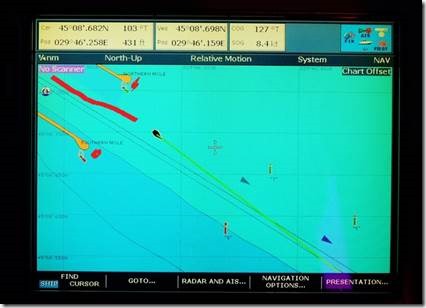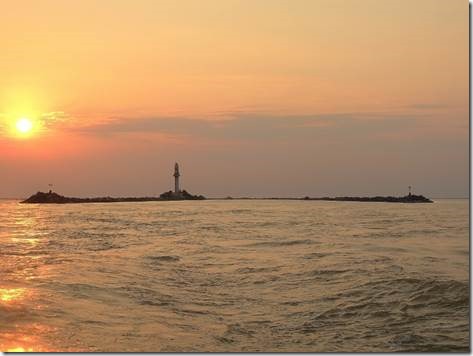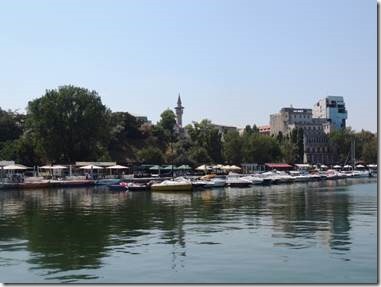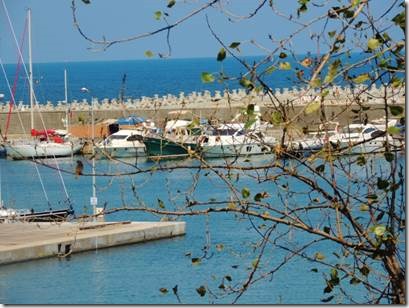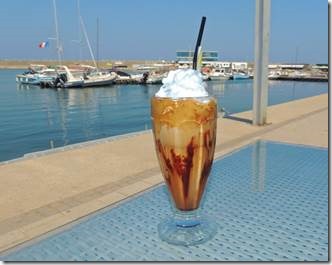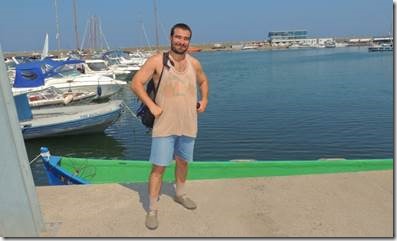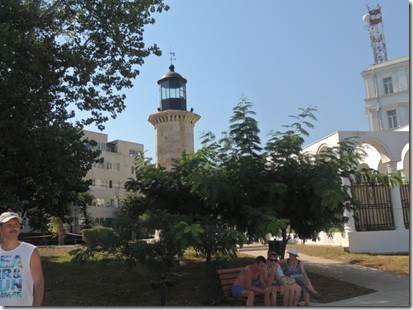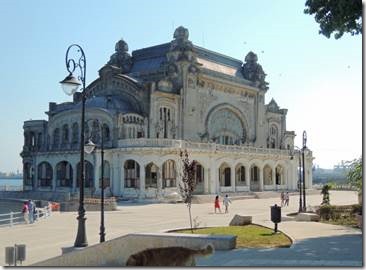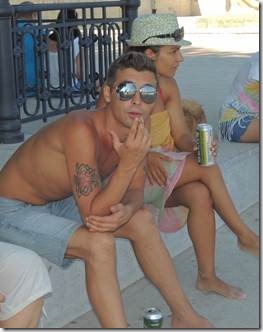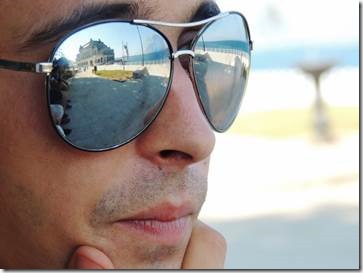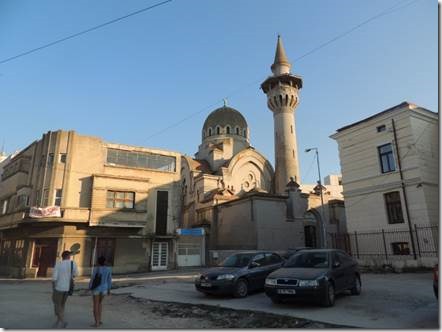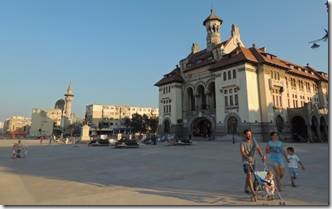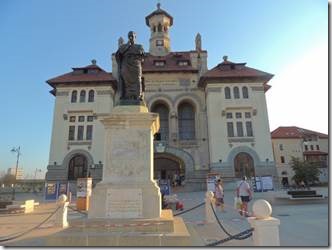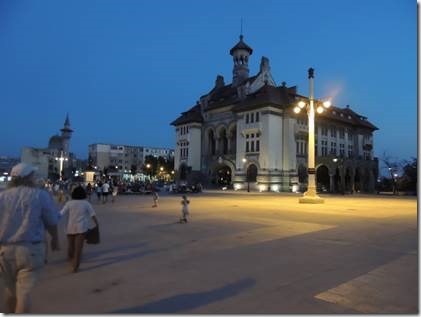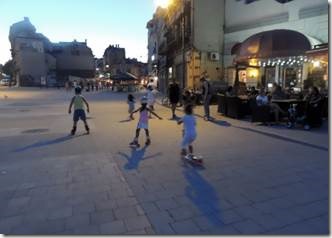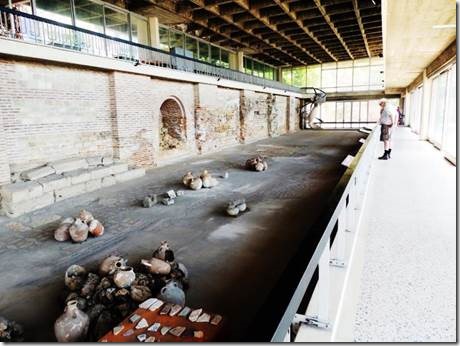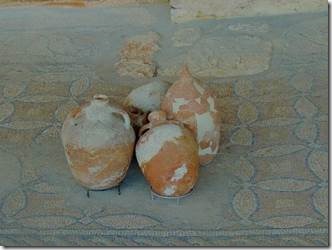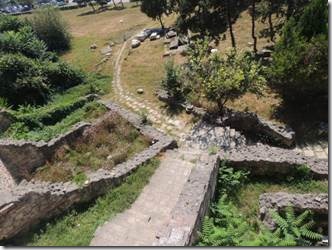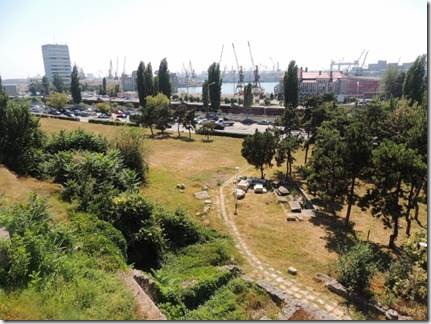Sozopol Marina
Sozopol, Bulgaria
добър вечер dobŭr vecher Good Evening
We left Varna about 7 am and arrived here in Sozopol about 3:45 pm. The plan, at this point, is to leave Wednesday for an overnight passage through the Bosporus towards Istanbul. It all depends on the weather exactly what day we’ll leave. Sozopol is small enough to enjoy for a few days with an old town as well as a “new town.”
This email is the first of several about Port Tomis/Constanta. It was another “favorite” and a place one could spend much more time. And it was our final stop in Romania.
Ru
|
Leaving Sulina and the Danube behind at 6:55 pm for a night passage to Constanta I’ve “painted” the 12 kilometers of canal bordered by stone breakwater quays . You can see two boats going ahead of us from the canal to the Black Sea. Looking back as the sun set as we began our journey into the Black Sea |
|
Port tomis/Constanta 9:30 am was our arrival time in Constanta We were tied stern-to on the back wall of Marina Bay marina which was rimmed all round with restaurants, cafes, and ice cream shops. Looks great but not an Israeli ice coffee!!! But we made do. |
|
Stefan Diamandi, future mariner Stefan was intrigued by the heavy socks and boots both Randal and I were wearing. Most tourists in hot places wear sandals or sneakers so Stefan is intrigued by those who wear boots. He took our photo and I took his. In Vidin I met interesting women, but in Romania we met interesting men. (We wear boots because they’re just more supportive for all the walking we do.) |
|
City Highlights Situated at the crossroads of several commercial routes, Constanta lies on the western coast of the Black Sea, 185 miles from the Bosphorus Strait. An ancient metropolis and Romania’s largest sea port, Constanta traces its history some 2,500 years. Originally called Tomis, legend has it that Jason landed here with the Argonauts after finding the Golden Fleece. Founded by Greek colonists from Miletos in the 6th century BC, Tomis was conquered by the Romans in 71 BC and renamed Constantiana by Roman Emperor Constantine the Great in honor of his sister. The name was shortened to Constanta during the Ottoman era. During the 13th century, Italy, especially Genoese merchants, dominated the Black Sea and Constanta flourished, only to decline two centuries later under Turkish rule. Fine mansions and hotels were built in the 19th century when King Carol I decided to revive Constanta as a port and seaside resort. Constanta is the fourth largest port in Europe, ranked just after Rotterdam, Antwerp and Marseille. The third largest city in Romania, Constanta is now an important cultural and economic centre, worth exploring for its archaeological treasures and the atmosphere of the old town centre. Its historical monuments, ancient ruins, grand Casino, museums and shops, and proximity to beach resorts make it the focal point of Black Sea coast tourism. Open-air restaurants, nightclubs and cabarets offer a wide variety of entertainment. http://romaniatourism.com/constanta.html also has info about all the landmarks we saw |
|
The Genoese Lighthouse (Farul Genovez) Address: Str. Remus Opreanu Soaring 26 feet, this lighthouse was built in 1860 by the Danubius and Black Sea Company to honor Genoese merchants who established a flourishing sea trade community here in the 13th century. |
|
The Casino (Cazinoul) Address: Blvd. Carpati 2 During the 1914 visit of the Russian Imperial Family, the casino was host to a royal gala. Despite diplomatic negotiations, Grand Duchess Olga refused the proposed marriage to Prince Carol of Romania and the Russians sailed away. The Grand Duchess was later killed by the Bolsheviks along with the rest of her family. Completed between the two World Wars in art nouveau style according to the plans of the architects, Daniel Renard and Petre Antonescu, the Casino features sumptuous architecture and a wonderful view of the sea. The pedestrian area around the Casino is a sought-after destination for couples and families, especially at sunset. http://romaniatourism.com/constanta.html From a distance, the Art Nouveau building on a promenade beside the Black Sea looks majestic. As you walk closer, however, Casino Constanta reveals itself: broken windows, curling paint, and rusted railings hint at the dilapidation inside. The casino, located in the southeast Romanian city of Constanta, was inaugurated in 1910. With its grand size, seaside location, and marine-themed decor, Casino Constanta soon attracted wealthy travelers and became a symbol of the city. But its glory days were short-lived. Romania’s changing fortunes in the face of two world wars saw the casino fall into disrepair. During the Second World War, the building was used as a hospital. Under the post-war communist regime, it operated as a restaurant. By 1990, the place had become so run down that it was too expensive to maintain. The building has been closed ever since, a silent sentinel on the edge of the Black Sea. |
|
Bogdan Nicodin gave us a lesson in Romanian and Eastern European modern history. It’s always so interesting to hear from someone who lives in a place there version of the country’s history. His politics were similar to ours so we found what he said quite believable. A very wise, witty, charming young man. |
|
Ovid Square was the center of the old town area and full of charming buildings in various stages of repair and disrepair. The Great Mahmudiye Mosque (Moscheea Mare Mahmoud II) Address: Strada Arhiepiscopiei 5 (Ovidiu Square) Built in 1910 by King Carol I, the mosque is the seat of the Mufti, the spiritual leader of the 55,000 Muslims (Turks and Tatars by origin) who live along the coast of the Dobrogea region. The building combines Byzantine and Romanian architectural elements, making it one of the most distinctive mosques in the area. The centerpiece of the interior is a large Persian carpet, a gift from Sultan Abdul Hamid. Woven at the Hereche Handicraft Centre in Turkey, it is one of the largest carpets in Europe, weighing 1,080 pounds. The main attraction of the mosque is the 164-ft minaret (tower) which offers a stunning view of the old downtown and harbor. Five times a day, the muezzin climbs 140 steps to the top of the minaret to call the faithful to prayer. |
|
National History & Archeology Museum Constanta – Glykon (Muzeul de Istorie Nationala si Arheologie) Address: Piata Ovidiu 12 An impressive collection of artifacts from Greek, Roman, and Daco-Roman civilizations is on display illustrating the history of Dobrogea from the Stone Age to modern days. Greek and Roman objects can be found on the main floor. Two statues, one of the "Glykon – The Fantastic Snake," dating from the 3rd century BC, and the other of "Goddess Fortuna and Pontos," god of the Black Sea, are considered protectors of the city and port and are the highlights of the collection. Ovidiu’s Square Constanta – Publius Ovidius Designed by the sculptor Ettore Ferrari in 1887, the statue dedicated to the Roman poet, Ovidius Publius Naso, gives name to this square. Emperor Augustus exiled Ovid to Tomis in 8 AD. The House with Lions Constanta – History and Archeology Museum (Casa cu Lei) Address: Str. Nicolae Titulescu 9 Blending pre-Romantic and Genovese architectural styles, this late 19th century building features four columns adorned with imposing sculptured lions. During the 1930s, its elegant salons hosted the Constanta Masonic Lodge. http://romaniatourism.com/constanta.html Everything comes alive at night with the cooler temperatures |
|
The Roman Mosaics (Edificul Roman cu Mozaic) Address: Piata Ovidiu 12 (next to the National History & Archeology Museum) A vast complex on three levels once linked the upper town to the harbor. Today, only about a third of the original edifice remains, including more than 9,150 sq ft of colorful mosaics. Built toward the end of the 4th century AD and developed over the centuries, it was the city’s commercial centre until the 7th century. Archeological vestiges point to the existence of workshops, warehouses and shops in the area. Remains of the Roman public baths can still be seen nearby. Aqueducts brought water six miles to the town. http://romaniatourism.com/constanta.html The new commercial port in the background |

